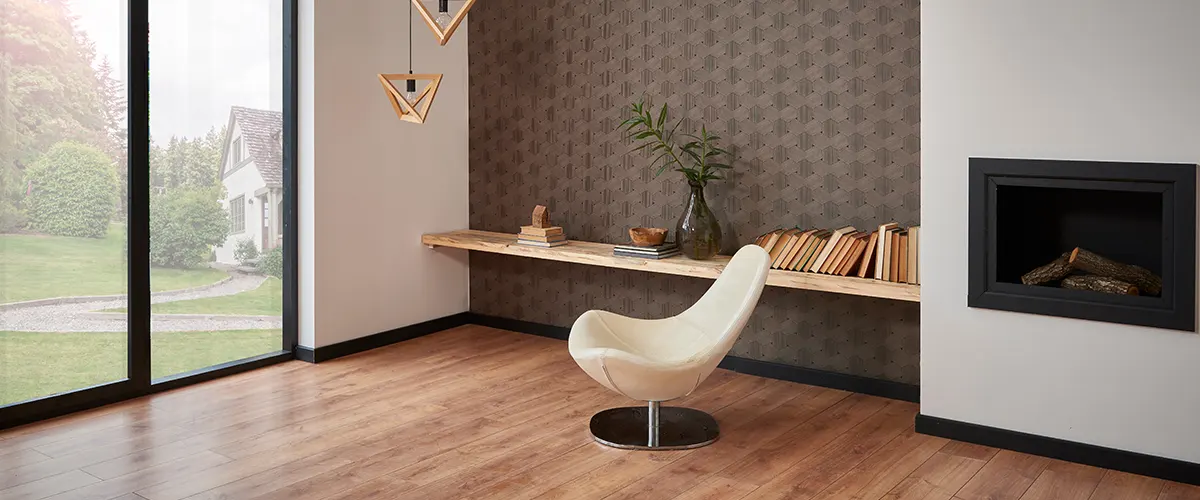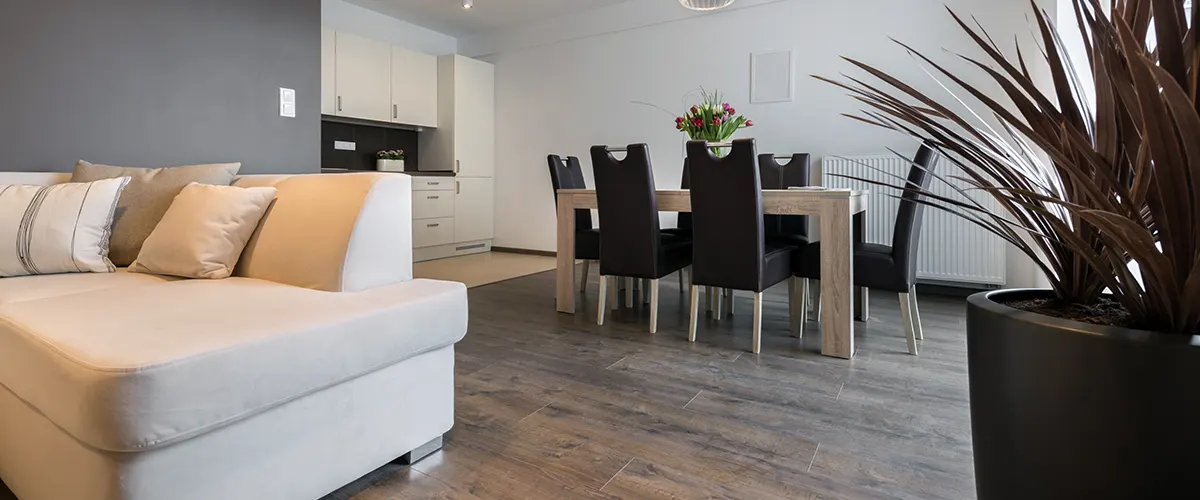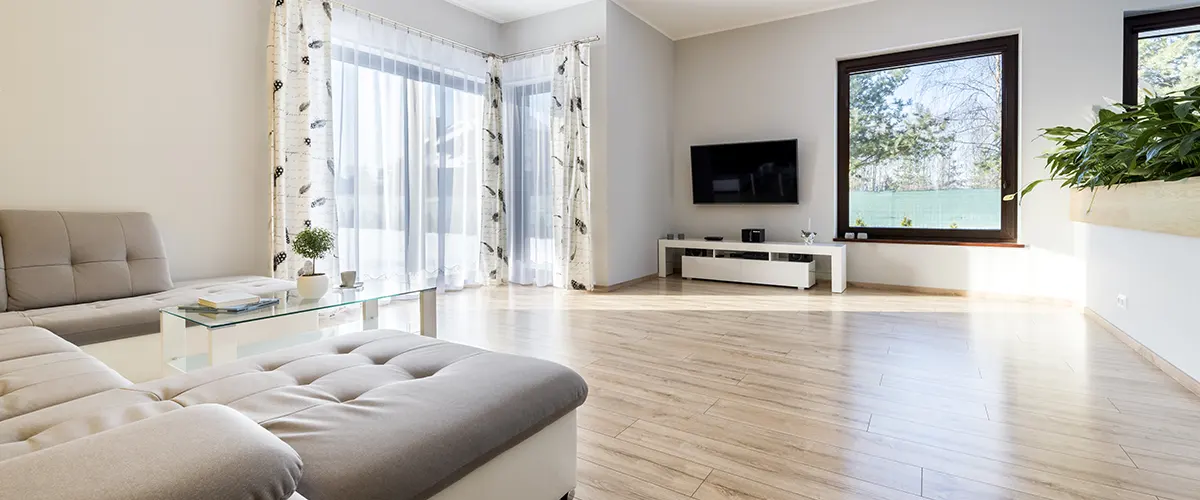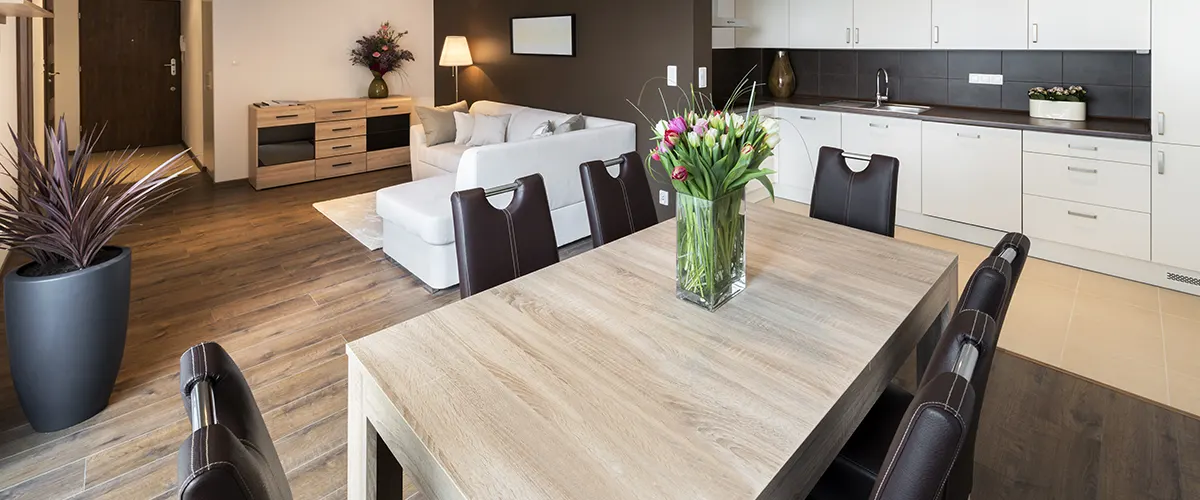When it comes to flooring, there are a lot of choices out there. You can go with laminate, vinyl, hardwood flooring, or even tile. So which one should you choose? It depends on your specific needs and what you’re looking for on a floor.
In this blog post, we will compare laminate vs vinyl flooring so that you can make an informed decision about which type of flooring is best for you.

What is Vinyl Flooring?
Most standard vinyl flooring is made up of four layers of synthetic materials, with the backing layer being the bottom one. This layer is generally made from cork or foam and its main function is to act as an underlayment for the vinyl flooring so that you don’t have to install another material first.
The backing layer also serves as a cushion, making it more comfortable to walk on, and acts as a sound barrier to keep noise levels down.
When choosing vinyl flooring for your home, it’s important to consider all of the different features and benefits that the different layers provide. By understanding the role of each layer, you can be sure to choose a product that will meet your needs and provide you with the best possible results.
What is Laminate Flooring?
Laminate flooring is a popular choice for many homeowners because it is durable and affordable. Unlike natural flooring options like wood, stone, or cork, laminate is a synthetic material made up of four different layers—wear, décor, core, and backer—sealed together in the lamination process.
The décor layer is a printed image that can recreate the look of more expensive flooring types like wood, tile, or stone. Laminate flooring is easy to clean and maintain, and it is available in a variety of colors and styles to suit any home décor. If you are considering laminate planks for your home, be sure to consult with a professional to ensure that it is the right choice for your needs.
Additionally, when comparing laminate flooring to vinyl flooring ranges, you will find that vinyl options also offer a wide variety of types and pricing, from sheet vinyl to plank vinyl, which can influence your decision based on budget and material preference.

Laminate vs Vinyl: What Looks Best In Your Home?
Appearance: Vinyl Flooring
When shopping for vinyl plank or tile flooring, you may notice that some options look more realistic than others. This is generally due to the quality of the flooring. Higher quality vinyl flooring usually has an image or photo layer under the hard, clear wear layer. This image is usually of a wood species (for example, oak, maple, or hickory) or, less commonly, stone. The image gives the luxury vinyl flooring a realistic look and feel.
Not all vinyl flooring has this realistic look, though. Older and lower-priced sheet and tile vinyl flooring doesn’t have the same realistic look like higher quality options. When choosing vinyl plank, be sure to consider the quality of the product to get the look you want.
Appearance: Laminate Flooring
When it comes to laminate floors, one of the most notable features is their appearance. You can find nearly every color, species, and variety of natural wood floors and stone flooring in laminate form. There is an option for everyone from hand-scraped and rustic looks to reclaimed wood.
Laminate flooring can also be found in various finishes, including multi-tonal, natural, whitewashed, and more. No matter what your personal style may be, there is sure to be a laminate floor that is perfect for you. And because it is so durable and easy to maintain, you can enjoy your new floors for years to come.

Vinyl and Laminate Flooring: Similarities
- Laminate and vinyl flooring cost about the same, ranging from $1 per square foot for basic products and $6 per square foot for high-quality ones with the average cost being $3 per square foot.
- Installation methods are similar in both cases.
- Both feature realistic depictions of wood, stone, and other natural materials.
- Both are low-maintenance, stain-resistant flooring options, requiring only occasional sweeping and mopping.
- Laminate and vinyl plank flooring are both excellent choices for radiant floors. They conduct heat equally well and have similar lifespans, easily lasting 10 to 25 years.
- Top-quality laminate and vinyl plank flooring can also increase a home’s resale value. That being said, not all laminate and vinyl products are created equal. Inferior products may not offer the same benefits in terms of heat conductivity or lifespan. When choosing laminate or vinyl plank flooring, be sure to select a high-quality product to get the most value for your money.
- Ultimately, both laminate and vinyl offer homeowners a beautiful and low-maintenance floor.
Laminate and Vinyl Flooring: Differences
- Laminate is made of multiple layers of synthetic material sealed together with a photographic image of wood, stone, or other natural material on the surface.
- Vinyl planks are made of a single layer of solid vinyl with a photographic image printed on top. Because it is a solid piece of material, vinyl is more resistant to water damage than laminate.
- As opposed to hardwood floors, luxury vinyl planks are also softer and warmer to the touch than laminate, making them more comfortable to walk on.
- Laminate is more durable and scratch-resistant than vinyl, however, and it can be refinished if it becomes damaged.
- Vinyl floors are available in a wider range of formats, including VCT and sheet flooring. And because they have a textured surface, they can closely resemble natural materials like stone or wood.

Cost and Value
When it comes to cost and value, both laminate and vinyl flooring are competitive options that cater to various budgets. Vinyl flooring typically ranges from $1 to $6 per square foot, depending on the quality and brand.
Basic sheet vinyl flooring is on the lower end of the spectrum, while luxury vinyl planks can be more expensive due to their enhanced durability and realistic appearance.
Laminate flooring also falls within a similar price range, generally costing between $1 and $6 per square foot. The price can vary based on the thickness of the laminate planks, the quality of the photographic layer, and the brand. High-end laminate floors that mimic the look of natural wood or stone can be more costly but offer a premium aesthetic.
In terms of value, both laminate and vinyl flooring provide excellent longevity and aesthetic appeal. Vinyl flooring is particularly valued for its water resistance and ease of installation, making it a great choice for areas prone to moisture.
On the other hand, laminate flooring is appreciated for its scratch resistance and ability to replicate the look of more expensive flooring materials. Ultimately, the best choice depends on your specific needs and budget.
Durability and Performance
Both laminate and vinyl flooring are renowned for their durability and performance, but they excel in different areas. Vinyl flooring, especially luxury vinyl planks, is highly resistant to water and moisture, making it an ideal choice for bathrooms, kitchens, and basements.
Its solid construction and wear layer ensure that it can withstand heavy foot traffic and resist stains and spills.
Laminate flooring, while not as water-resistant as vinyl, is exceptionally durable when it comes to resisting scratches and dents. This makes it a suitable option for households with pets or children. The wear layer on laminate floors protects against everyday wear and tear, ensuring that the flooring maintains its appearance over time.
In terms of performance, vinyl flooring stands out for its comfort underfoot and sound absorption qualities, thanks to its cushioned backing layer. Laminate flooring, on the other hand, offers a more rigid feel but compensates with its ability to mimic the look of natural wood and stone closely.
Both options provide excellent performance, but the choice will depend on the specific demands of your living space.
Installation and Maintenance
Both laminate and vinyl flooring are relatively easy to install and maintain, making them popular choices for DIY enthusiasts and professional installers alike. Vinyl flooring, particularly luxury vinyl planks and tiles, often features a click-lock installation system that allows the planks to snap together without the need for adhesives.
Sheet vinyl flooring can be a bit more challenging to install due to its size and the need for precise cutting and fitting.
Laminate flooring also utilizes a click-lock system, making it straightforward to install over most subfloors. One advantage of laminate is that it can be installed as a floating floor, meaning it doesn’t need to be glued or nailed down, which can save time and effort during installation.
When it comes to maintenance, both laminate and vinyl flooring are low-maintenance options. Regular sweeping and occasional mopping with a damp cloth are usually sufficient to keep them looking their best.
However, it’s important to avoid excessive water on laminate floors, as it can cause the planks to swell or warp. Vinyl flooring, being more water-resistant, can handle more moisture without damage.
In summary, both laminate and vinyl flooring offer easy installation and maintenance, but vinyl has a slight edge in moisture-prone areas. Your choice will depend on your specific installation preferences and the conditions of the room where the flooring will be installed.
Top Manufacturers
When selecting laminate and vinyl flooring, it’s important to consider reputable manufacturers known for quality and durability.
Armstrong Flooring: Renowned for innovative designs and superior resilience, offering a wide range of stylish products.
Mohawk Industries: Industry leader with a focus on sustainability and cutting-edge technology in flooring solutions.
Shaw Floors: Offers extensive choices in both vinyl and laminate, emphasizing craftsmanship and material integrity.
Pergo: Pioneer in laminate flooring known for its durability, creativity, and easy installation features.
Karndean Designflooring: Specializes in luxury vinyl flooring, blending artistry with performance for unique, elegant designs.
FAQs About Laminate vs Vinyl Flooring
Conclusion
So, what’s the verdict? Laminate or vinyl flooring – which is best for your home? The answer really depends on your specific needs and budget. If you want a floor that looks like wood and is affordable, laminate may be the best option for you.
But if you’re looking for a more affordable, easy-to-install option that still has a natural look and feel, vinyl may be better suited for your needs. Give us a call today to discuss your options in detail and we would be happy to help you choose the perfect flooring solution for your home!
